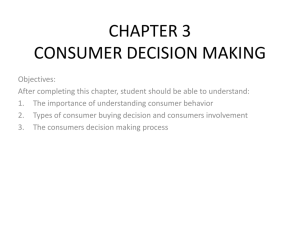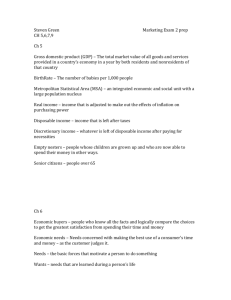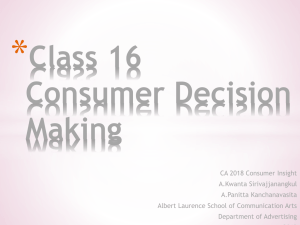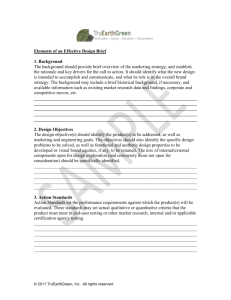Consumer Decision Making Process: A Detailed Guide
advertisement
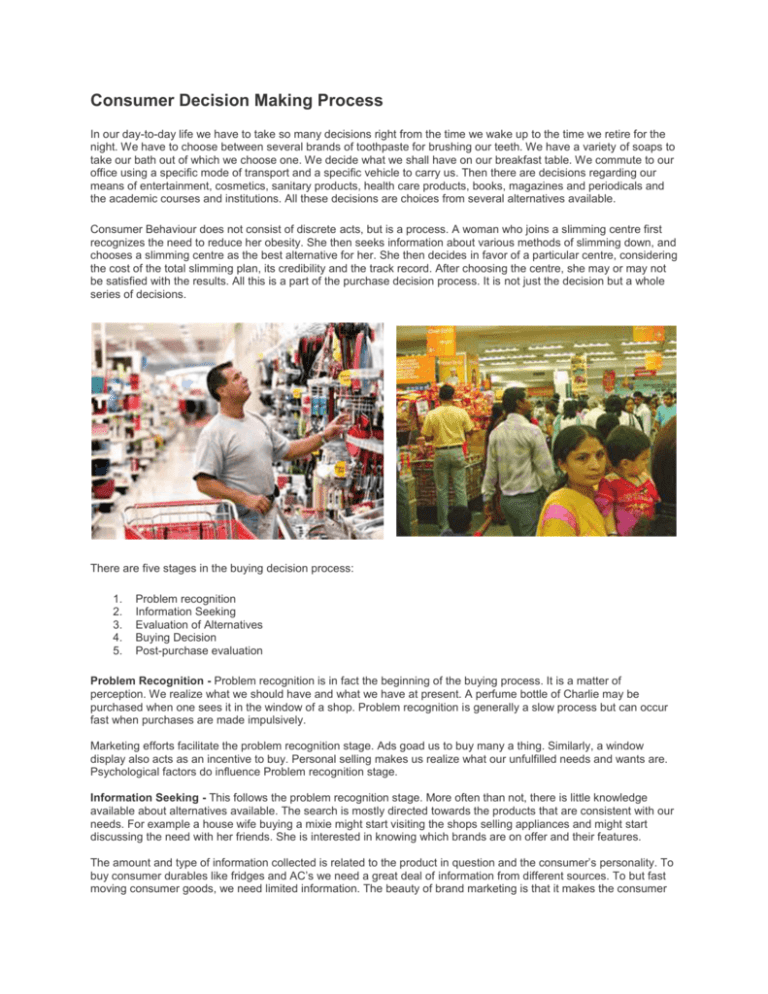
Consumer Decision Making Process In our day-to-day life we have to take so many decisions right from the time we wake up to the time we retire for the night. We have to choose between several brands of toothpaste for brushing our teeth. We have a variety of soaps to take our bath out of which we choose one. We decide what we shall have on our breakfast table. We commute to our office using a specific mode of transport and a specific vehicle to carry us. Then there are decisions regarding our means of entertainment, cosmetics, sanitary products, health care products, books, magazines and periodicals and the academic courses and institutions. All these decisions are choices from several alternatives available. Consumer Behaviour does not consist of discrete acts, but is a process. A woman who joins a slimming centre first recognizes the need to reduce her obesity. She then seeks information about various methods of slimming down, and chooses a slimming centre as the best alternative for her. She then decides in favor of a particular centre, considering the cost of the total slimming plan, its credibility and the track record. After choosing the centre, she may or may not be satisfied with the results. All this is a part of the purchase decision process. It is not just the decision but a whole series of decisions. There are five stages in the buying decision process: 1. 2. 3. 4. 5. Problem recognition Information Seeking Evaluation of Alternatives Buying Decision Post-purchase evaluation Problem Recognition - Problem recognition is in fact the beginning of the buying process. It is a matter of perception. We realize what we should have and what we have at present. A perfume bottle of Charlie may be purchased when one sees it in the window of a shop. Problem recognition is generally a slow process but can occur fast when purchases are made impulsively. Marketing efforts facilitate the problem recognition stage. Ads goad us to buy many a thing. Similarly, a window display also acts as an incentive to buy. Personal selling makes us realize what our unfulfilled needs and wants are. Psychological factors do influence Problem recognition stage. Information Seeking - This follows the problem recognition stage. More often than not, there is little knowledge available about alternatives available. The search is mostly directed towards the products that are consistent with our needs. For example a house wife buying a mixie might start visiting the shops selling appliances and might start discussing the need with her friends. She is interested in knowing which brands are on offer and their features. The amount and type of information collected is related to the product in question and the consumer’s personality. To buy consumer durables like fridges and AC’s we need a great deal of information from different sources. To but fast moving consumer goods, we need limited information. The beauty of brand marketing is that it makes the consumer loyal to the brands. These consumers then continue to buy the same brands and do not seek any information at all. Information seeking starts with cognitive internal search – recalling information stored in memory. This may lead to further stages of buying decision process. Alternatively, the consumer may start external search, seeking information from sources other than memory. The major external sources are peers, friends, colleagues, relatives whom we trust. In addition, we get information from different marketing communications, media, distribution channels and consumer’s own experience. Evaluation of Alternatives - When the consumer seeks information he realizes the alternative choices available to him and gets the background against which these choices can be judged. The brands which a consumer considers while making a purchase decision forms an evoked set, which is a small proportion of the total brands available. Each brand in the evoked set is evaluated against some chosen criteria. A consumer may want to look into the following criteria before buying a product. These may be the Brand name, the price, the functions performed, the appearance and looks, Reputation of the company, Warranty Specifications, Technical specifications as also the After sales service available. Each of the criteria is assigned some weightage, which may differ from consumer to consumer. After this it is all a matter of perception. To illustrate, flavour of sharbat may have equal importance for 2 different consumers. But one feels Rasna orange has very good flavour whereas the other feels that it is awful. Promotion, especially advertising, provides information to the consumers, enabling him to evaluate the different alternatives. Buying Decisions - After the alternative choices are evaluated, the brands are ranked, and the top- ranking brand may be purchased. The ultimate buying decision may undergo a change, if the preferred brand is not available. In such a situation, the second – ranked brand may be bought. The ultimate buying occurs only when the consumer finds a suitable outlet where the brand is available, and price negotiations are complete. Post - Purchase Evaluation - Now the product has been bought and consumed. It is the stage for post-purchase evaluation. The consumer may either be satisfied or dissatisfied. A satisfied consumer stores the product information in his memory and uses it next time at the time of problem recognition stage. A dissatisfied consumer may go for another brand next time he is out to buy. He will seek additional information and will consider another set of brands. Thus, consumer decision making is an extensive process. Promotions play a vital role helping customers decide during the process. But, the companies should keep in mind that they do not rub in the offers for it may work adversely for them.

